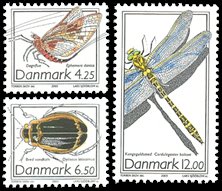The
Stamps

The stamp comes from set of 3 insects
designs.
This stamp issue represents Post
Denmark's tribute to our aquatic environment and the outstanding results
achieved by the 1987 and 1998 Aquatic Environment Plans. One of the eminently
quantifiable effects of those plans has been the rapid rise in the number
of insects that only flourish in clean water. Of the three insects selected
as stamp motifs, only the mayfly has been removed from the Danish Forest
and Nature Agency's list of endangered species so far but the golden-ringed
dragonfly is making such a rapid recovery that it may be removed from the
list at the next update.
There are 52 different species of
dragonfly in Denmark. They are extremely colourful and aerodynamic. Depending
on the species, they are airborne from early May until late October but
most of them prefer warm sunny summer weather when there is plenty of food
in the air in the form of small insects. Many of them have their own territory
- i.e. sexually mature males who dominate an area close to a good breeding
site, preferably one with clean fresh water. Young dragonflies, especially
the larger species, roam far and wide. Some species even migrate hundreds
of kilometres, so some of the dragonflies found in Denmark actually come
from abroad. The females lay their eggs in nearby wetlands, boring them
into plants, etc., which are then covered by water, paving the way for
the next generation.
|